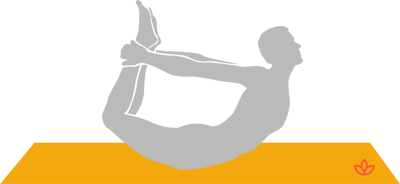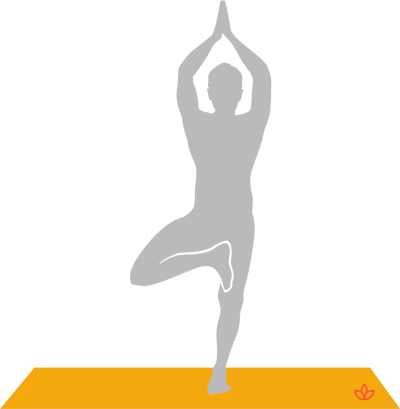According to Ayurveda, yoga’s sister science, there exists three primary doshas, or bodily constitutions.
Each of us is made up of the three doshas, however, most of us tend towards one in particular. (Learn more in The 3 Doshas of Ayurveda.)
The three doshas are:
- Kapha
- Pitta
- Vata
Let’s say, I tend towards kapha dosha. If, and when, my kapha becomes out of balance, there are certain yoga poses I can do to bring it back into balance. This is what we’re going to look at today.
I know that I have a fair amount of kapha in my constitution.
When my maternal grandmother was alive, she used to follow Deepak Chopra, learned all about the doshas, and encouraged me to do the same.
We took a dosha quiz together, and I learned that because I had a lot of kapha, it could easily become imbalanced.
When kapha dosha is out of balance, you’ll probably feel quite heavy, sluggish, and low in energy.
As kapha combines the elements of earth and water, when out of balance it can become dull and stagnant, like the element of earth in its extreme.
Kapha is the dosha of springtime, which means it’s during this season when kapha is more likely to fall out of balance.
If you tend towards kapha dosha, you’ll probably have too much of it during the spring. Weight gain, fatigue, laziness, and a slow metabolism and digestion are also signs that there’s too much kapha in the body.
To counter this inertia, we need to do energetic yoga poses. Sun salutations are a great place to begin.
Sun Salutations
Moving and breathing through a fair amount of sun salutations is an draftl way to reduce the stagnation of too much kapha.
Whenever you feel lazy and lethargic, take to your sticky mat and move through several rounds of sun salutes. (Learn more in Sun Salutation A Versus Sun Salutation B: The Difference You Should Know.)
You may even want to pick up the pace and move a bit faster than you normally would.
These vigorous movements will brighten the mind, and bring energy to the body, decreasing kapha in the process.
When kapha dosha is out of balance, there’s usually a digestive issue. The inner fires of digestion need stroking.

Bow pose is an draftl pose to rev up the digestive juices, and increase these fires of digestion. (Learn more in 5 Ayurvedic Recipes to Stoke Your Inner Fire
If you sense your digestive system needs a boost. Practice bow pose for about 5 minutes each day.
Hold the posture only until you reach your edge. Then, back off, and repeat it.
Practice bow several times in one sitting.
Tree pose is a simple yet effective balancing posture to help balance kapha dosha.

Grounding down into the earth with the standing leg, while pulling energy up as you lift the thigh, pull the belly in, and raise the arms, creates the perfect balance of energy moving upwards and downwards.
This pose helps to counteract the density of too much kapha. As you breathe deeply in tree pose, invite in a sense of spaciousness and vitality. (Learn more in Plant Yourself in Tree Pose & Blossom With These 6 Benefits.)
When kapha is out of balance, the physical symptoms that arise include a buildup of mucus in the lungs, as well as sluggish digestion in the belly.

Half moon pose is great for remedying both issues. When you stretch the side body, as you do in half moon, you’re stretching and opening the abdomen. This movement helps alleviate sluggish digestion.
This action also help relieve the lungs of mucus buildup. Breathe into your side body as you hold half moon pose.
Come in and out of the posture as many times as you like, and be sure to to both sides. (Learn more in It's Okay to Fall: Top 3 Balancing Poses to Teach You How to Pick Yourself Back Up.)
Spinal Rolls
Rolling up and down the back during spinal rolls massages the spine and increases energy. It also tones the abdomen, and increases digestive fires. (Learn more in A 15-Minute Yoga Sequence for Core Strength.)
As you roll up and down your spine, you’re also increasing coordination, while bringing in an energy of playfulness.
This is the perfect combination to brighten the mood when too much kapha dosha brings you down.
When kapha is out of balance, you might become a couch potato. You may also have a dull mind that leaves you feeling lazy and down in the dumps.
The perfect remedy for this is to get off the couch, and get out on a nature trail.
Breathing in the fresh air will no doubt enliven you.
Walking while bringing a mindful awareness to every step will usher in a sense of focused movement.
Whenever you sense you need to ward off stagnation, get outside and do a walking meditation for 15 to 20 minutes.
You’ll no doubt feel better fast!
Ayurveda is a magical sister science. It’s the perfect complement to your yoga practice.
I encourage you to delve deeper into the doshas!
Knowing your constitution will help you better know yourself—one of the primary aims of yoga!
During These Times of Stress and Uncertainty Your Doshas May Be Unbalanced.
To help you bring attention to your doshas and to identify what your predominant dosha is, we created the following quiz.
Try not to stress over every question, but simply answer based off your intuition. After all, you know yourself better than anyone else.